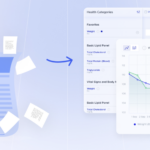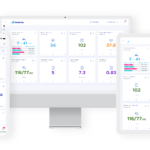Photo by silviarita
Comprehensive guide to losing weight with GLP-1’s.
Weight loss is a common struggle for many individuals, and with the numerous options available for managing weight, it can be overwhelming to find the most effective method. One possible solution that has gained attention is the use of GLP-1 medications. In this article, we will explore how long you should take GLP-1’s for weight loss, the types of GLP-1 medications available, and the potential benefits and risks associated with their use.
Understanding GLP-1 and Its Role in Weight Loss
Before discussing how long to take GLP-1’s for weight loss, it is essential to understand what GLP-1 is and how it contributes to weight management. GLP-1, or glucagon-like peptide-1, is a hormone naturally produced by the body that plays a crucial role in regulating blood sugar levels and appetite. GLP-1 medications work by mimicking the effects of this hormone, ultimately leading to weight loss through a variety of mechanisms.
Mechanisms of Action for GLP-1 Medications
GLP-1 medications exert their weight loss effects through several mechanisms, which include:
- Appetite suppression: GLP-1 medications help reduce hunger by acting on the brain’s appetite control center, leading to a decrease in overall food intake.
- Slowing gastric emptying: These medications slow down the rate at which the stomach empties, prolonging the feeling of fullness and reducing the desire to consume more food.
- Improving insulin sensitivity: GLP-1 medications can improve insulin sensitivity, allowing the body to use glucose more effectively and potentially reducing the risk of developing type 2 diabetes.
By targeting these different aspects of weight management, GLP-1 medications can aid in achieving and maintaining weight loss goals.
Types of GLP-1 Medications for Weight Loss
There are several types of GLP-1 medications available, each with its unique properties and characteristics. Some of the most commonly prescribed GLP-1 medications for weight loss include:
- Liraglutide: Marketed under the brand name Saxenda, liraglutide is a once-daily injectable GLP-1 medication approved for weight loss in adults with a BMI of 30 or higher or those with a BMI of 27 or higher with at least one weight-related comorbidity.
- Semaglutide: Known by the brand name Wegovy, semaglutide is a once-weekly injectable GLP-1 medication that has shown promising results in weight loss and is approved for similar indications as liraglutide.
- Exenatide: Available under the brand names Byetta and Bydureon, exenatide is another injectable GLP-1 medication typically prescribed for type 2 diabetes management but has also demonstrated weight loss benefits.
While each of these medications works similarly, they may differ in terms of dosing frequency and potential side effects. It’s essential to consult with a healthcare provider to determine the most suitable GLP-1 medication for your needs.
So, How Long Do I Take GLP-1’s for Weight Loss?
The duration of GLP-1 medication use for weight loss will depend on several factors, including individual response, the specific medication prescribed, and the presence of any underlying medical conditions. It is essential to work closely with a healthcare provider to determine the appropriate length of treatment for your unique situation. That being said, some general guidelines can offer insight into how long GLP-1’s may be taken for weight loss:
- Short-term use: Some individuals may only require a short course of GLP-1 medication to achieve their weight loss goals. This could range from a few weeks to several months, depending on the individual’s response to treatment and the specific medication used.
- Long-term use: In some cases, GLP-1 medications may be prescribed for long-term use, particularly for individuals with chronic weight management issues or underlying medical conditions that warrant ongoing treatment. Long-term use may be necessary to maintain weight loss and prevent weight regain.
Ultimately, the duration of GLP-1 medication use will be determined on a case-by-case basis, taking into account the individual’s needs, goals, and overall health.
Potential Benefits of GLP-1 Medications for Weight Loss
GLP-1 medications offer several potential benefits for individuals struggling with weight loss, which include:
- Significant weight loss: Studies have shown that GLP-1 medications can lead to substantial weight loss, with some individuals losing up to 10% or more of their initial body weight.
- Reduced risk of weight-related comorbidities: By aiding in weight loss, GLP-1 medications can help reduce the risk of developing weight-related health conditions, such as type 2 diabetes, hypertension, and heart disease.
- Improved quality of life: Achieving and maintaining a healthy weight can lead to improvements in overall health, well-being, and quality of life.
- Non-surgical option: For individuals who may be considering weight loss surgery, GLP-1 medications offer a non-surgical alternative that can still yield significant weight loss results.
Potential Risks and Side Effects of GLP-1 Medications
As with any medication, there are potential risks and side effects associated with GLP-1 medications, which may include:
- Gastrointestinal side effects: Some of the most common side effects of GLP-1 medications are gastrointestinal in nature, such as nausea, vomiting, diarrhea, and constipation. These side effects are generally mild and tend to improve over time.
- Hypoglycemia: GLP-1 medications can cause low blood sugar levels, particularly when taken in combination with other diabetes medications. It’s essential to monitor blood sugar levels regularly and adjust treatment as needed to prevent hypoglycemia.
- Pancreatitis: While rare, some cases of pancreatitis have been reported in individuals taking GLP-1 medications. If you experience severe abdominal pain, nausea, vomiting, or fever while taking a GLP-1 medication, contact your healthcare provider immediately.
- Injection site reactions: As GLP-1 medications are injectable, some individuals may experience reactions at the injection site, such as redness, swelling, or pain. Rotating injection sites and using proper injection technique can help minimize these reactions.
Monitoring and Adjusting GLP-1 Medication Use for Weight Loss
It is crucial to regularly monitor and assess your progress while taking GLP-1 medications for weight loss. This may involve tracking changes in body weight, BMI, waist circumference, and other relevant health metrics. It’s also essential to communicate with your healthcare provider throughout the process, as they can help guide and adjust your treatment plan as needed to ensure the best possible outcomes.
Final Thoughts on How Long to Take GLP-1’s for Weight Loss
In conclusion, determining how long to take GLP-1’s for weight loss will depend on individual factors, including response to treatment, specific medication prescribed, and underlying medical conditions. Working closely with a healthcare provider can help you develop a personalized treatment plan that yields the best results for your unique needs. By understanding the potential benefits and risks associated with GLP-1 medications, you can make informed decisions about your weight loss journey and work towards achieving a healthier, happier version of yourself.



















